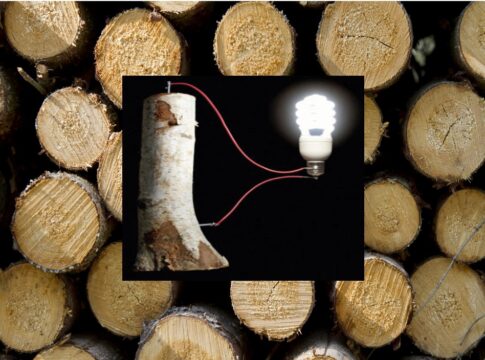Batteries From Wood: A Renewable Energy Storage Solution
Companies worldwide are working on a sustainable power storage solution using renewable biowaste called lignin to make wood batteries.
One of the largest private forest owners in the world, Stora Enso, recently built a production facility worth €10 million to create bio-based carbon by turning trees into batteries.
Producing these wood batteries is possible by using a biomaterial known as lignin.
How Lignin is Made to Create Wood Batteries
Lignin is one of the most common organic polymers, second to cellulose, that’s abundant in the cell walls of some plants. It makes the structure of the plant firm and doesn’t easily rot.
This biomaterial makes up about 30% of the wood’s total composition. In fact, it’s present in all vascular plants and can have a carbon content as high as 60%.
Lignin separates from wood during the production of cellulose fibers from its pulp. After extraction, the by-product is turned into a fine carbon powder.
The powder is then made into electrode sheets and rolls. The sheet can then go with other battery parts, replacing mined graphite, which has a much larger carbon footprint.
Advocates believe that the carbon found in lignin would be enough to end the use of fossil fuels and mined metals in making lithium-ion batteries that need graphite to work.
Here is the process of making batteries from lignin.
According to Stora Enso:
“With Lignode, we can provide a bio-based, cost-competitive and high-performance material to replace the conventionally used graphite… To serve the fast-growing anode materials market, we are now exploring strategic partnerships to accelerate scale-up and commercialisation in Europe.”
The Northvolt Deal
Stora Enso is joining forces with Volkswagen-backed battery developer Northvolt to produce lignin-based batteries. The source for the wood batteries will be from Nordic forests under sustainable management.
Through the partnership, Northvolt will be responsible for cell design, production process development, and scale-up of the technology. While Stora Enso will provide the wood-based anode material lignin.
The deal comes when critical mineral availability poses a significant barrier in sustainable battery and energy storage systems. The creation of renewable batteries offers a greener alternative to the critical mineral geopolitical chess game.
Apart from being one of the largest renewable sources of carbon, the use of lignin in producing wood batteries brings many benefits.
Key Benefits of Lignin-Based Wood Batteries
Graphite has been the main source of making lithium-ion batteries used in making electric cars. For Tesla to make its annual target of 20 million EVs, it has to mine ~1 million tonnes of graphite.
Add to this the future demand for electric airplanes and almost all other portable electronic devices. Hence, engineers find it bothersome how the world can meet those future demands for e-mobility.
Wood Batteries offer 5 major benefits as a renewable energy technology:
Scalability: viable to produce wooden batteries commercially due to the wide availability of the resource needed to make them – trees.
Sustainability: By sourcing raw materials from sustainability-certified forests.
Renewability: By using natural resources removes the need to source battery manufacturing in China and other regions that have a higher carbon intensity.
Faster charging: a fully functional wood battery can charge at a faster rate than fossil-fuel derived graphite.
Better performance at lower temperatures: the battery is operational under cooler temperatures, making it possible to for a wider range of operations .
Lignin-based carbon is applicable in storing energy for a wide variety of uses, power automotive systems. This industry has seen tremendous growth after the pandemic with a 46% increase in sales of EVs such as scooters and e-bikes.
The post Batteries From Wood: A Renewable Energy Storage Solution appeared first on Carbon Credits.



